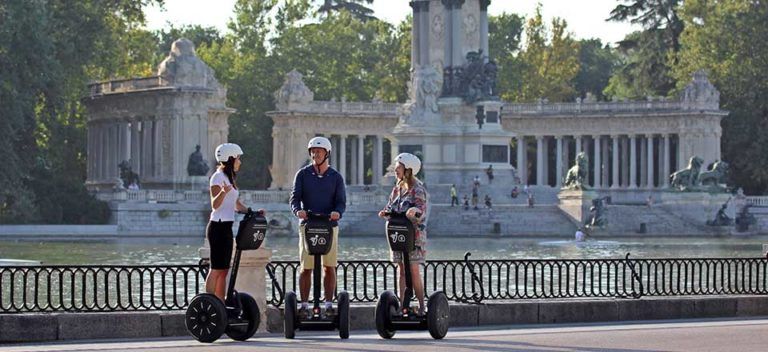The Gran Vía of Madrid: What to Know Before Traveling to the Spanish Capital
The Gran Vía of Madrid is that street that you will cross more than once when you come to the city. And sure that every time you do it, you will discover something new. Shops, restaurants, emblematic buildings, hotels, cinemas and theaters. The well-known Broadway in Madrid is a place with history and always trendy.
Today we will know a little more about everything you can find here to enjoy your visit to the Spanish capital as locals do. And strolling along the Gran Vía of Madrid is something you can not miss. And, what has been said, you will repeat every time you come back to the city, and maybe even on the same day…
TABLE OF CONTENTS
A bit of history about the Gran Vía of Madrid
The first known sketches of the Gran Vía of Madrid date back to 1862. However, its final design dates from 1899, the work of the architects José López Salaberry and Francisco Octavio Palacios. Its construction started in 1910 and ended 19 years later. More than 300 streets were demolished and another 50 were affected to build this street.
It was a step towards the modernization of the Spanish capital as the first skyscrapers in the city appeared, and, also, communications between the center and the northwest improved markedly.
What to see in the Gran Vía of Madrid
The building of the Gran Vía
When you walk along the Gran Vía of Madrid we recommend you look up, so you can admire all its buildings.
You can not miss the Metropolis building, which you’ll find at the intersection of Gran Vía and Calle Alcalá. It is one of the icons of Madrid, easily recognizable by its black dome presided over by the sculpture of the Winged Victory.
The Telefonica building, spectacular on the outside and with many activities inside, will not leave you indifferent either. It measures 89 meters high; It was the first skyscraper built in Spain and one of the first in Europe. From 1929 to 1953 it was the highest in Madrid, a title that snatched the Edificio España, located in the square of the same name, Plaza de España.
And we are sure you will take a photo in front of another of the most emblematic buildings on this street: the Capitol building, declared this year as a Cultural Interest by the Government of the Community of Madrid, a decision taken for its iconic character in the city and also for its architectural style. The neon of the Schweppes brand is one of its hallmarks.
The Callao square
Callao square, Plaza Callao in Spanish, is the square presided over by the Capitol building and we think it is an obligatory stop on your tour around the Gran Vía of Madrid. During the 20s there were many movie theaters, and it is worth noting, in addition to the building that we have already mentioned, the Callao cinemas and the Palacio de la Música (the Music Palace).
Here you can also see the Palacio de la Prensa (the Press Palace), built between 1925 and 1929 and designed as an American-style multifunctional building; In addition to being the headquarters of the association of the company, it had houses, a cinema and offices. At that time, it was the tallest building in the city (14 floors) but was dethroned with the construction of the Telefónica building.
The cinemas and theatres
The Gran Vía of Madrid welcomes a full cultural offer. Its cinemas and its theaters will allow you to enjoy musicals, monologues, films and performances that will make your visit to the city acquire a tinge of the most artistic.
The Rialto Theater, the Capitol Theater, the Coliseum Theater, the Chocita del Loro, the Teatro de la Luz, the Philips Gran Vía, the Lope de Vega Theater, the Arlequín Theater, the Callao Cinemas or the Capitol Cinema are some of the places in which, when the curtain goes up, everything can happen.
The shops and restaurants
We have already seen the most emblematic buildings of the Gran Vía de Madrid. Now it’s time to go shopping and taste the delicious dishes of the city.
The Gran Vía is a street where you will find all kinds of establishments for your shopping, for lunch and dinner. You will be surprised by the size of its stores, as some of the most famous such as Zara or Primark have several floors.
As for restaurants, you can go for tapas, eat delicious hamburgers or sit down at a restaurant for a more elaborate menu. The offer is extensive, both on the avenue itself and on the adjacent streets.
The Museo Chicote, La Primera, El Mercado de la Reina or Five Guys if you want to enjoy Obama’s favorite burgers are some of the options you’ll find on this street, but there are many more.
Real Oratorio del Caballero de Gracia
Maybe an unknown treasure for a lot of people, that you can also see during your walk through the center of Madrid. The Royal Oratory of the Caballero de Gracia is an architectural work by Juan de Villanueva with a neoclassical style reminiscent of a Roman basilica.
In its interior you’ll find the image of the Holy Christ of Agony, that dates from the century XVII. It also highlights an organ, work of Dutch Van Gruisen, 1790, which was recovered for the city in 2011. It is a unique jewel, wonderful and of high quality.
And so far our proposals for you to enjoy your visit to the Gran Vía of Madrid and do not miss anything that this busy, cosmopolitan and magical street can give you. We believe you will return.








